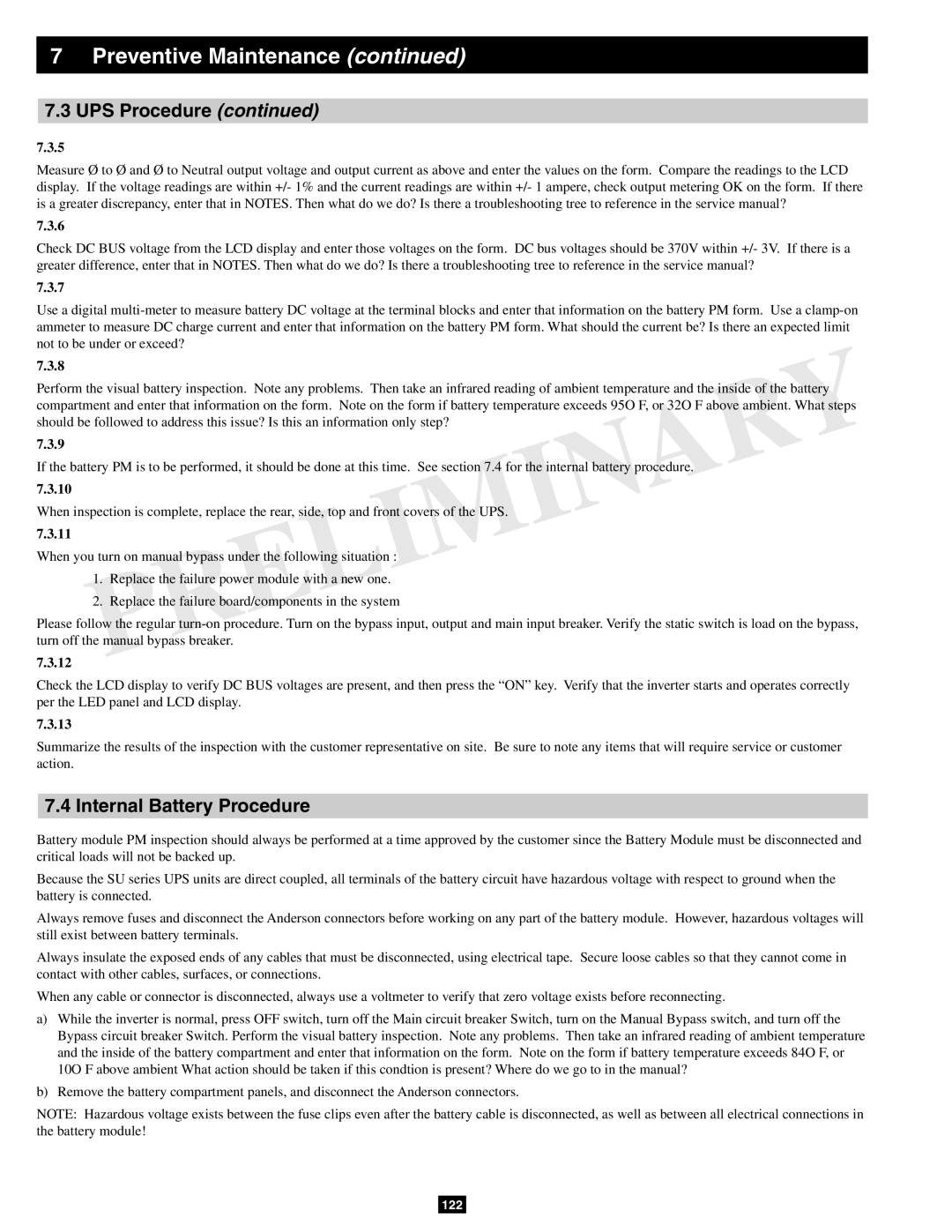
7 Preventive Maintenance (continued)
7.3 UPS Procedure (continued)
7.3.5
Measure Ø to Ø and Ø to Neutral output voltage and output current as above and enter the values on the form. Compare the readings to the LCD display. If the voltage readings are within +/- 1% and the current readings are within +/- 1 ampere, check output metering OK on the form. If there is a greater discrepancy, enter that in NOTES. Then what do we do? Is there a troubleshooting tree to reference in the service manual?
7.3.6
Check DC BUS voltage from the LCD display and enter those voltages on the form. DC bus voltages should be 370V within +/- 3V. If there is a greater difference, enter that in NOTES. Then what do we do? Is there a troubleshooting tree to reference in the service manual?
7.3.7
Use a digital
7.3.8
Perform the visual battery inspection. Note any problems. Then take an infrared reading of ambient temperature and the inside of the battery compartment and enter that information on the form. Note on the form if battery temperature exceeds 95O F, or 32O F above ambient. What steps should be followed to address this issue? Is this an information only step?
7.3.9
If the battery PM is to be performed, it should be done at this time. See section 7.4 for the internal battery procedure.
7.3.10
When inspection is complete, replace the rear, side, top and front covers of the UPS.
7.3.11
When you turn on manual bypass under the following situation :
1.Replace the failure power module with a new one.
2.Replace the failure board/components in the system
Please follow the regular
7.3.12
Check the LCD display to verify DC BUS voltages are present, and then press the “ON” key. Verify that the inverter starts and operates correctly per the LED panel and LCD display.
7.3.13
Summarize the results of the inspection with the customer representative on site. Be sure to note any items that will require service or customer action.
7.4 Internal Battery Procedure
Battery module PM inspection should always be performed at a time approved by the customer since the Battery Module must be disconnected and critical loads will not be backed up.
Because the SU series UPS units are direct coupled, all terminals of the battery circuit have hazardous voltage with respect to ground when the battery is connected.
Always remove fuses and disconnect the Anderson connectors before working on any part of the battery module. However, hazardous voltages will still exist between battery terminals.
Always insulate the exposed ends of any cables that must be disconnected, using electrical tape. Secure loose cables so that they cannot come in contact with other cables, surfaces, or connections.
When any cable or connector is disconnected, always use a voltmeter to verify that zero voltage exists before reconnecting.
a)While the inverter is normal, press OFF switch, turn off the Main circuit breaker Switch, turn on the Manual Bypass switch, and turn off the Bypass circuit breaker Switch. Perform the visual battery inspection. Note any problems. Then take an infrared reading of ambient temperature and the inside of the battery compartment and enter that information on the form. Note on the form if battery temperature exceeds 84O F, or 10O F above ambient What action should be taken if this condtion is present? Where do we go to in the manual?
b)Remove the battery compartment panels, and disconnect the Anderson connectors.
NOTE: Hazardous voltage exists between the fuse clips even after the battery cable is disconnected, as well as between all electrical connections in the battery module!
122
